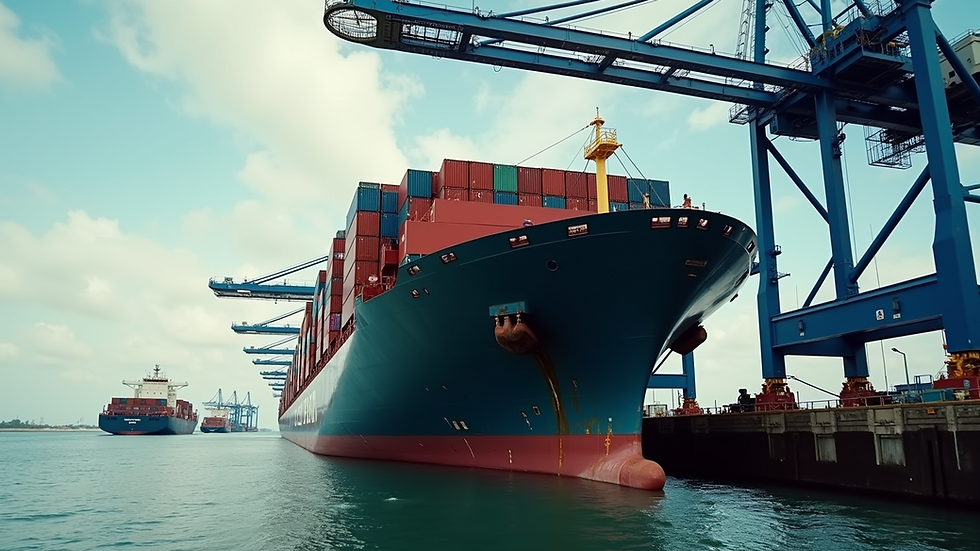Boosting Cargo Bookings With SEO Strategies
- Org Ns
- Nov 2
- 4 min read
In the competitive world of cargo and freight services, standing out online is essential to attract more clients and grow your business. Many cargo companies struggle to get noticed by potential customers searching for reliable shipping options. The solution lies in using smart SEO strategies tailored to the cargo industry. This post explains how you can improve your website’s visibility, attract targeted traffic, and ultimately boost your cargo bookings.

Understanding SEO for Cargo Services
Search Engine Optimization (SEO) is the process of improving your website so it ranks higher on search engines like Google. When your site appears on the first page of search results, more people find your services. For cargo businesses, this means more inquiries and bookings.
SEO is not just about stuffing keywords. It involves creating useful content, optimizing your website’s structure, and building trust with search engines. The goal is to connect with customers who are actively looking for cargo shipping solutions.
Researching Keywords That Matter
The foundation of any SEO strategy is keyword research. You need to know what terms potential clients use when searching for cargo services. These might include:
Cargo shipping companies
Freight forwarding services
International cargo transport
Container shipping rates
Air freight services
Use tools like Google Keyword Planner, Ahrefs, or SEMrush to find keywords with good search volume and low competition. Focus on long-tail keywords—phrases that are more specific and less competitive, such as “affordable international cargo shipping from New York.”
Creating Content That Answers Questions
Once you know the keywords, create content that answers your customers’ questions. This builds trust and positions your company as an expert. Examples of helpful content include:
Guides on how to prepare cargo for shipment
Explanations of different shipping methods (air, sea, land)
Tips for reducing shipping costs
Updates on customs regulations and paperwork
Blog posts, FAQs, and detailed service pages help your site rank for multiple keywords. Use clear headings and bullet points to make content easy to scan.
Optimizing Website Structure and Speed
A well-structured website helps search engines understand your content and improves user experience. Key points to focus on:
Use descriptive URLs (e.g., yoursite.com/international-cargo-shipping)
Organize pages logically with clear menus
Include internal links between related pages
Ensure your website loads quickly on all devices
Page speed is crucial. Slow sites frustrate visitors and get penalized by search engines. Use tools like Google PageSpeed Insights to identify and fix issues.
Building Local SEO Presence
Many cargo clients prefer working with companies nearby or in specific regions. Local SEO helps you appear in searches with geographic intent. To improve local SEO:
Create a Google Business Profile with accurate contact details
Encourage satisfied clients to leave reviews
List your business in local directories and industry-specific platforms
Use location-based keywords (e.g., “cargo shipping in Los Angeles”)
Local SEO increases your chances of showing up in “near me” searches and Google Maps results.
Leveraging Backlinks From Industry Sources
Backlinks are links from other websites to yours. They signal to search engines that your site is trustworthy and authoritative. To get quality backlinks:
Partner with logistics blogs or news sites for guest posts
Share case studies or success stories with industry associations
Sponsor or participate in cargo and shipping events
Collaborate with suppliers or clients who can link to your site
Avoid buying links or using low-quality sources, as this can harm your rankings.
Using Analytics to Track Progress
SEO is an ongoing process. Use tools like Google Analytics and Google Search Console to monitor your website’s performance. Track metrics such as:
Organic traffic growth
Keyword rankings
Bounce rates
Conversion rates (inquiries or bookings)
Analyze which pages perform best and where visitors drop off. Use this data to refine your SEO strategy and improve weak areas.
Practical Example: How One Cargo Company Increased Bookings
A mid-sized cargo company focused on international shipping wanted to increase bookings from Europe. They started by researching keywords related to “European cargo shipping” and created detailed guides on customs procedures and shipping options for European countries. They optimized their website structure and improved page speed.
Next, they built local SEO by creating profiles in European logistics directories and encouraged clients to leave reviews. They also wrote guest articles for European trade blogs, earning valuable backlinks.
Within six months, their organic traffic doubled, and inquiries from European clients increased by 40%. This example shows how targeted SEO efforts can deliver measurable results.
Final Thoughts on Boosting Cargo Bookings
SEO is a powerful tool to grow your cargo business online. By focusing on relevant keywords, creating helpful content, optimizing your website, and building local presence, you can attract more qualified leads. Remember to track your progress and adjust your strategy based on real data.
Start by identifying the keywords your customers use, then build content that answers their needs. Improve your website’s speed and structure to keep visitors engaged. Build relationships in the industry to earn backlinks and boost your authority.
With consistent effort, your cargo service will become easier to find online, leading to more bookings and business growth. Take the first step today by reviewing your website’s SEO and planning your next moves.







Comments